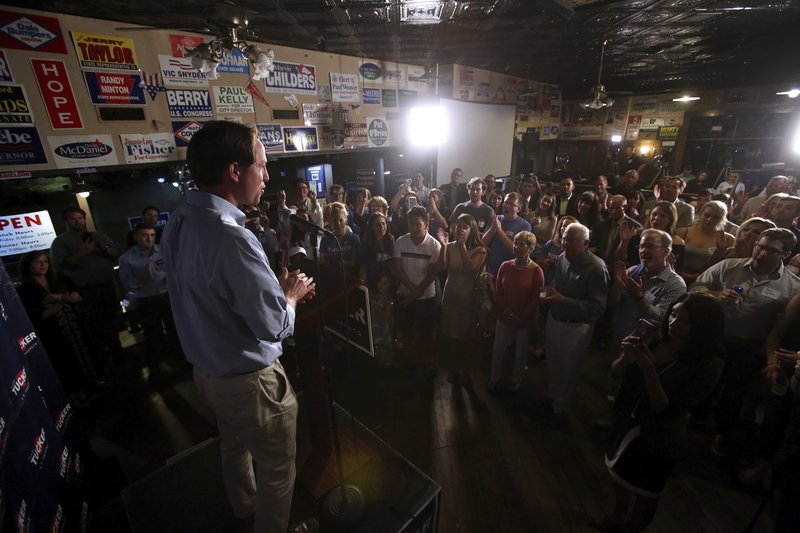Weeks into the primary season, with five more states voting today, Democrats are shaping up to test what liberal messages the party can sell to the moderate and GOP-leaning voters who will help determine control of the House after the November midterm election.
It's not one size fits all, with every candidate checking every box wanted by the activists who are driving the opposition to President Donald Trump and the GOP-led Congress. And Democratic voters typically aren't tapping the most liberal choices in targeted districts.
But, taken together, the crop of candidates is trending more liberal than many of the Democrats who were swept away in Republicans' 2010 midterm romp.
That means voters now represented by a Republican will be asked to consider some or all of the mainstream Democratic priorities that may have been considered "too liberal" in the past: more government involvement in health insurance, tighter gun laws, a path to citizenship for people in the country illegally, reversing parts of the GOP tax law, and support for gay rights.
"You have ... 60 districts as diverse as Kansas and Staten Island [in New York]. One bumper-sticker message will be self-defeating," said former U.S. Rep. Steve Israel of New York, who led Democrats' national House campaign in 2012.
The question is whether that path results in Democrats gaining the 23 new seats they need to capture a majority in the House.
The next test will come with today's primaries in five states: Maine, Nevada, North Dakota, South Carolina and Virginia.
A key measure of Democrats' leanings will come in suburban northern Virginia, where vulnerable Republican Barbara Comstock has a half-dozen Democrats vying to win her seat in November. The Democratic field includes establishment favorite Jennifer Wexton, a state senator who touts her bipartisan deal-making in Richmond and says the U.S. should move cautiously toward universal health insurance, and political newcomers with calls for a $15-per-hour minimum wage and a more immediate move to single-payer, government health insurance.
Israel disputes that the current House slate represents a notable leftward shift nationally, and national party leaders have angered liberals with some of their recruitment choices.
Still, liberal activists are confident of their influence.
"We are seeing grass-roots action and organizing in a meaningful way," said Maria Urbina, national political director of Indivisible, a group founded after Trump's 2016 election.
Not every hopeful is a carbon copy of Bernie Sanders, the 2016 presidential candidate whose campaign emboldened the left with his calls for universal health insurance, a $15 minimum wage and tuition-free college. But the influence of Sanders' base is palpable, as winning nominees have adopted pieces, if not the whole, of an agenda that has become more typical within the party since it lost the House majority eight years ago.
So far, the party has staved off a Democratic version of the 2010 tea party rise, when GOP leaders, even as they marched in lockstep opposition to then-President Barack Obama, watched more conservative outsiders defeat incumbent Republicans and fundamentally reshape the party's identity on Capitol Hill. The Democratic path seems to be a more incremental evolution.
A key indicator is the Democratic Congressional Campaign Committee's "Red to Blue" program, the party's top candidates for flipping Republican seats. Twenty candidates with that designation have faced primaries already; only one of them -- among the party's most conservative choices -- has lost. About two dozen more Red to Blue candidates have upcoming primaries, and the committee could add to its list.
On health care, at least two of the Red to Blue hopefuls who won their primaries call explicitly for single-payer health insurance. Four others want a government-run public option, and several others generically call for expanded coverage under the Democrats' 2010 health insurance overhaul.
A leftward shift on health care is clear in Arkansas, where state Rep. Clarke Tucker dominated the primary in a congressional district that Trump won handily in 2016.
A cancer survivor, Tucker does not support single-payer health care, but he does say that all Americans, regardless of age, should be able to buy Medicare coverage. For state Democrats, that's a leap from 2010, when then-Sen. Blanche Lincoln, a self-declared Arkansas centrist, joined other moderate Democrats to back the Patient Protection and Affordable Care Act only after a public option was scrapped. She lost her 2010 re-election bid in a landslide anyway.
A Section on 06/12/2018

